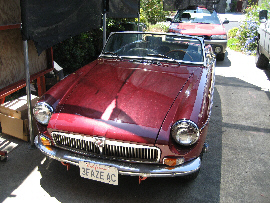Silicon Productions 

The MGB Electric Sports Car
Analysis by Warren Winovich
Page 6
As a point of comparison of the acceleration capability of the MGB electric sports car, the calculated value for the quarter-mile run is given in figure 8 with measured times for several home-built and production electric cars. The calculated value for the MGB electric-powered car for the quarter-mile is
Critique of the analytical methods employed. The application of the general equations of motion to determine the performance is well-founded by tests in which economy and range between charging are compared to calculated values. Agreement in the range of 10 % descrepancy is deemed acceptable. The degree of agreement depends on the reliability of the values from specifications of designs adopted for the electric car.
For the present study, the greatest uncertainty is the specifications of the induction motor installed in the MGB. The estimate used here is based on a visual examination of the installation - aided by the fact that the motor had a specially wound stator to accommodate higher currents for a 70-volt, three-phase system. A 15-kW, three-phiase, four-pole design was assumed based on scant information. Further, it is tacitly assumed that starting torque is limited to three times rated torque. The ratio between starting torque and rated torque for standard-design induction motors is quoted as 3:1; however, premium-design models are available with a ratio as high as 6:1. For the present study, a conservative decision was made to adopt the lower ratio for the installation in the MGB electric sports car. The result is rather low ( but, acceptable for practical driving ) acceleration performance. Note that EV drivers placing high in drag-racing competitions have cars with two-speed transmissions, shift at optimum speeds, 'burn-out' tires before their runs, and frequently install smaller battery packs to minimize driving weight.
Concluding remarks. An analytical procedure has been used to determine the performance of an MGB electric sports car. The design features incorporated in this conversion represent the modern trend to use induction motors. A unique feature of this conversion is the low-voltage inverter/control that provides a conventional driving sensation with regenerative braking. Results are summarized below.
| economy of energy usage | 246 w-hrs/mi @ 50 mph, highways |
| range between charging | 20 miles @ 50 mph, 100 % DOD |
| 12 miles @ 50 mph, 60 % DOD | |
| acceleration performance | 0 - 30 mph: |
| 0 - 50 mph: |
|
| ¼ - mile |
Page 6
Start Previous Page Next Page
Page 1 2 3 4 5 6 7 8 9 10 11 12 13 14 15 16